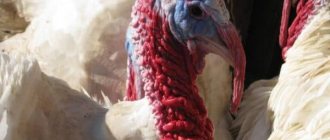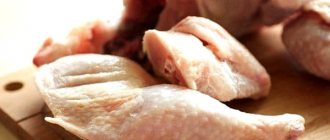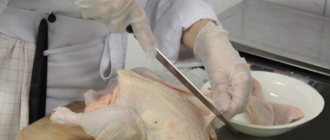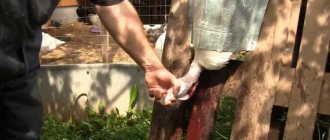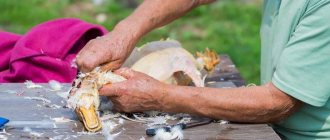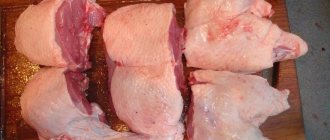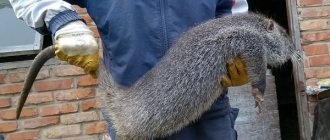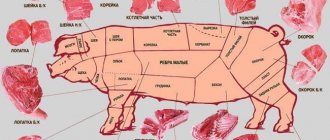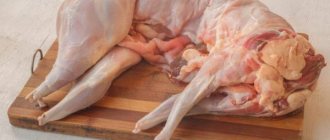Poultry farming » Turkeys
0
2375
Article rating
Kira Stoletova
Turkeys are the leaders among poultry in meat production. From one pure breed you can get twelve kilograms of pure meat, and for cross-breeds this figure can reach eighteen kilograms. However, in order to extract the maximum amount of the final product, certain slaughter rules must be followed. Before slaughtering a turkey, it needs to be fattened and prepared, and then plucked and dressed. There are several ways to kill a bird, and they require certain skills among poultry farmers.
Rules for slaughtering turkeys at home
Preparing a turkey for slaughter
Turkeys of various breeds are usually slaughtered at eight months of age. By this time, the bird weighs about twelve kilograms if properly fattened. Broiler lines grow faster than conventional breeds and can reach this weight at six months, while laying and breeding males are slaughtered at two to three years of age. Usually by this time the birds have already lost their productive qualities. If such time restrictions are not maintained, the meat loses its taste and becomes rough. If turkey is raised for slaughter at home, this requires a large amount of concentrates. Usually, for this purpose, special early maturing crosses are purchased, which practically do not require walking; this will make their cultivation several times easier.
Turkeys should be slaughtered at home before the molting process begins. If the bird has changed its plumage, it will not be successfully plucked. Dark spots will remain on the skin, which reduce the cost of meat when sold.
Immediately before slaughtering turkeys, a set of measures must be taken. Preparatory work includes:
- Before slaughter, turkeys should not be fed for 24 hours.
- Birds should be placed in a dark room with free access to water.
- Glauber's salt is added to turkeys' drink to better cleanse the intestines.
- Two weeks before slaughter, the bird should be given rye flour and wet bran.
It should be remembered that one turkey eats several kilograms of grain, so complete cleansing of the intestines may take some time. If you do not carry out such procedures, then during gutting you can stain the meat. In addition, if you do not cut up a carcass with dirty intestines in time, the remaining feces can poison the product.
There are different recommendations for when to slaughter turkeys, but the size of the bird at this point should be at least twelve kilograms. If the required weight has not been achieved, then keeping the turkey will not pay off.
When to carry out
Poultry that reaches a weight of over 12 kg is suitable for slaughter. Many turkeys reach these levels already at 33-35 weeks. You can wait until it weighs more, but you should remember that the meat of an adult bird does not have such a rich taste as a young one. However, if you slaughter young animals, the amount of meat will be less than expected.
How to determine readiness
The easiest way to understand that a bird is ready for slaughter is to consider its age. Turkeys stop gaining weight at 6-9 months. This period is considered the most favorable for slaughter. You should not wait until the bird gets older - its meat becomes coarser and loses its benefits and taste. In addition, adult males are no longer breeders, so keeping them any longer is costly and useless.
Turkey slaughter methods
Poultry slaughter at home can be done in several ways. On many farms, poultry farmers use an ax to kill a turkey. However, this method of killing is suitable for those individuals whose meat will be immediately processed. If the carcass is put up for sale, then decapitation is not suitable as a method of killing. Dirt and harmful bacteria can get into the laceration, and the appearance of the turkey loses its marketability.
Decapitation with an ax or carving knife is acceptable for older turkeys as this bird is quite difficult to restrain.
Another indicator of meat quality is maximum bleeding. So the best way to kill a bird is considered to be the closed slaughter method. In this case, the meat loses excess blood very quickly, and the final product retains its neat appearance.
How to pluck
Knowing how to kill and pluck a turkey correctly makes it much easier. So, after bleeding the carcass for 1 minute. dipped in hot water (60-65oC), after which they are cleaned of feathers. Plucking is done quickly while the skin pores are open. If they close, you will have to fiddle with the feathers for a long time.
When the turkey's skin is clean and smooth:
- her throat and mouth are freed from traces of blood;
- Adhered dirt and droppings are washed off from the paws;
- Use a napkin to remove any remaining moisture from the carcass.
Next comes scorching. It can be carried out over a regular gas stove, slowly turning the carcass over the flame.
The next stage is gutting.
Internal method of slaughter
For this method, long thin scissors with sharp blades are used. First, the beak is opened, after which the veins above the tongue are cut. In this part of the palate of turkeys, there are two important arteries - the jugular and the pontine. If their integrity is violated, the bird will quickly die from blood loss. After this procedure, the turkey is suspended by its legs for a while to allow excess liquid to drain through the resulting wound.
When cutting the veins, the bird's cerebellum should also be damaged with a precise injection. In this case, the turkey will become paralyzed and its muscles will relax. If you do not do this, the plucking procedure will be much more difficult.
After most of the blood has flowed out, you can remove the feathers and fluff. Males are plucked while the body is still warm, and females are processed while they are cool.
External method of slaughter
Each farmer has his own slaughtering habits
This method of killing birds does not preserve the quality of the final product as well, but it is suitable for birds over three years of age. The jugular vein is cut with a sharp slaughter knife from the outside of the neck, after which the turkeys are also hung by the legs to drain the blood. The blade of the killing device should be cone-shaped.
Farmers answer the question of how to properly slaughter a turkey in different ways, since each method has its own advantages and disadvantages. The method of slaughtering poultry mainly depends on how much the turkey weighs and how old it is. Beginners are advised to consult with experienced poultry farmers or watch training videos.
conclusions
- Slaughtering poultry is not easy - you need experience, dexterity and knowledge of the rules of cutting carcasses.
- Methods of slaughter - external and internal. The first one is used more often, although the second one is more “clean”.
- The faster you remove the blood from the carcass, the longer it will stay fresh.
- Scalding and roasting simplify the process of removing feathers, the main thing is not to cook or burn the meat (be careful and do not apply heat or fire for too long).
- Turkeys can be slaughtered when they reach 12 kg.
Read how to care for turkey poults here.
Plucking a bird
The procedure for removing feathers and plumage for turkeys is the same as for chickens and ducks. Some breeders prefer to dry pluck their birds after slaughter. This allows the meat to stay fresh longer. However, if several turkeys are slaughtered, then their carcasses are plucked using half-scald.
To do this, the flight and tail feathers are first removed, after which the dead body is doused with boiling water. It is important not to cook the turkey skin, otherwise this will affect the cost of the product. The water temperature should not exceed sixty degrees. Large feathers are removed in the direction of their growth, so the skin does not tear. Small feathers and fluff can usually be pulled in any direction. After the plucking procedure, the turkey is prepared for carving. To do this, excess blood is removed from the mouth, the legs and head are washed and wiped dry.
Searing the carcass
Searing the turkey after slaughter is necessary in order to give the carcass a marketable appearance. After plucking, small fragments of feathers remain that cannot be removed by hand. To get rid of them, you need to run a burner along the entire carcass, especially in hard-to-reach places - under the wings, in the leg area.
Gutting a turkey
To cut the carcass I use a special knife with a thin blade. They cut open the turkey's belly and then take out the stomach, liver and heart. There are two types of turkey gutting:
- Complete dissection - the neck is cut off down to the second vertebra and paw joints, and internal organs are removed.
- Incomplete cutting - the neck remains, the internal organs are washed and returned back to the abdominal cavity.
Turkeys are cut in different ways depending on age and breed. Complete evisceration is most often used for young animals with soft and dietary meat. Such individuals are usually used for baking as a whole.
Partial cutting is suitable for adult birds, whose meat is used for broths and minced meat. If the turkey is not completely gutted, it can be stored for no more than four days.
Step-by-step instructions for cutting a turkey
The basic cutting process looks like this:
- To begin, place the carcass on a hard surface. An ordinary cutting board, which is found in every kitchen, is ideal for this.
- Cut through the skin and ligaments where the thighs meet the turkey's body. Separate the legs from the drumsticks, then separate the wings from the carcass.
- Make an incision under the chest area where the internal organs were. Make this cut through the skin. When you reach the ribs, use special poultry scissors. Ordinary scissors will not work here, because their blade is duller and the pressure is less, so it is almost impossible to cut bones.
- As a result, the turkey is divided into the following parts: wings, thighs, breast, back and legs.
If you are going to cook the whole bird, there is no need to cut it up.
The process of carving a turkey is completely simple. The main thing is to follow the instructions to do everything correctly and not spoil the poultry meat.
1
0
Copy link
Meat storage
There are several ways to store turkeys before eating or selling:
- cellar or glacier;
- vacuum packaging;
- freezing containers.
The storage method depends on how much of the final product you end up with. Large quantities of meat can be kept in ice rooms or cellars. The product can be stored refrigerated for a week. If there are no places on the farm with a temperature of no higher than five degrees, then the carcass can be preserved by wrapping it in cloth soaked with the bite.
A salt solution will help extend shelf life. It is poured inside the bird a week after the turkey is slaughtered, filling the carcass halfway. Four hundred grams of salt are used for one liter of boiling water. The liquid should be cooled before processing. Afterwards, the throat hole is tightened with fishing line or thread, and the solution is kept in the turkey for about a day. After twenty hours, the thread is cut and the liquid is drained.
In this case, turkey carcasses can be stored in the cellar for another week. Vacuum packaging is considered a good storage method. With the help of a protective film, the carcass is protected from bacteria and dirt, and the vacuum does not allow the meat to rot. Turkeys are often offered for sale in this form. In addition, vacuum packaging allows you to preserve both whole poultry and individual parts. However, if the carcass is too large, then this storage method may not be suitable.
Freezing poultry
This procedure is mandatory for long-distance transportation of meat. Typically, freezing carcasses is combined with vacuum packaging of goods. Freezing, like slaughtering domestic turkeys, requires strict rules.
Before cooling the turkey, the carcass should lie for some time at a temperature of ten degrees. This is done so that the meat ripens and when the body cools, the bird freezes completely. Otherwise, only the top of the turkey will freeze, and the bottom may begin to rot within a few days.
The temperature in refrigerators should not drop below zero, since in this case muscle fibers begin to break down. Such meat will crumble and disintegrate after defrosting.
When frozen, turkey can be stored for two weeks and can withstand long-term transportation in special freezers. Thawing should be done gradually as meat can easily lose its texture and nutritional value. It is forbidden to use boiling water when defrosting meat, this will make it dry and tasteless.
Characteristics of the Big 6 cross
The weight of a mature turkey is 25 kg, females are much lighter, they reach 11 kg
The meat yield is 80% of body weight, thanks to which increased attention has been paid to their breeding. Turkeys begin laying eggs at 7 months, and in a year their number reaches 100 pieces, each weighing about 80 g. Hatching of chicks is 26-28 days
Hatching of chicks is 26-28 days.
Besides:
- egg hatchability – 85%;
- slaughter yield – 70-75%;
- muscle mass – 80%.
To grow 1 kg of live meat, you need to spend 2 kg of feed, and a turkey needs 250-350 g per day. The bird is slaughtered at 3-4 months, because it is not practical to keep it further, as growth stops.
